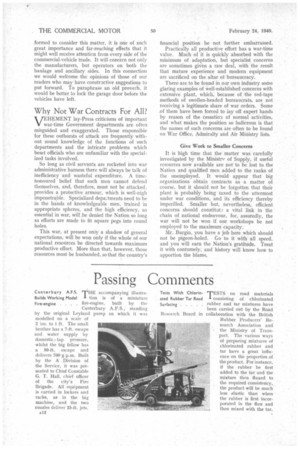Passing Comments
Page 14

Page 15

If you've noticed an error in this article please click here to report it so we can fix it.
HE accompanying illustration is of a miniature fire-engine, built by the Canterbury standing by the original Leyland pump on which it was modelled on a scale of 2 ins. to 1 ft. The small brother has a 7-ft. escape and water supply by domestic tap pressure, whilst the big fellow has a 50-ft. escape and delivers 700 g.p.m. Built by the A Division of the Service, it was presented to Chief Constable G. T. Hall, chief officer of the city's Fire Brigade. All equipment is carried in lockers and racks, as in the big machine, and the two nozzles deliver 25-ft. jets.
Al2
TESTS on road materials I consisting of chlorinated rubber and tar mixtures have been carried out by the Road collaboration with the British Rubber Producers' Research Association and the Ministry of Transport The various ways of preparing mixtures of chlorinated rubber and tar have a great influence on the properties of the product. For instance, if the rubber be first added to the tar and the mixture then fluxed to the required consistency, the product will be much less elastic than when the rubber is first incorporated in the flux and then mixed with the tar. Group of Bus ComI T is interesting to learn from panies Builds Gas Mr. F. Heaton's statement, at
Producers . . the annual general meeting of
Thomas Tilliag. Ltd., that experiments with alternative fuels have been carried Out by many of the companies constituting the group. These have given such encouraging results that certain bus services are being regularly operated by vehicles using producer gas obtained from anthracite. There is some loss of power and additional servicing costs, but improvements are being effected to such an extent that it may ultimately be found practicable to design a special engine for this purpose. At the Bristol . works, materials for making some 600 gas plants are available, and the manufacture of this number has been put in hand. In case of need, more may be built if raw materials be available. Only in a period of greater emergency, however, would any really substantial change-over he contemplated. The practical interest displayed should encourage many others to follow suit. The Regulation IDERHAPS the bodybuilders Fiends at Their Very I who have spent miserable Best afternoons in trying to placate
finicky customers who measure lettering with a slide rule, and the manufacturers and operators who have sat up all night grappling with incomprehensible regulations, will spare a grain of sympathy for the writer of A.R.P. signs. A standardized specification for direction signs for air-raid shelters and so on has been drawn up in which the dimensions of the various parts of the letters are expressed as obscure percentages of other dimensions. For instance, "the percentage of the width in relation to the height" of the letter "G" is " 75.00 in the standard alphabet. and 67.50 in the compressed alphabet. The length of the horizontal stroke is 27.5 per cent. of the height' of the letter and its upper edge is 45.00 per cent above the base line. The vertical stroke terminates an the base line." Perhaps the Construction and Use Regulations were not so difficult, after all?




















































